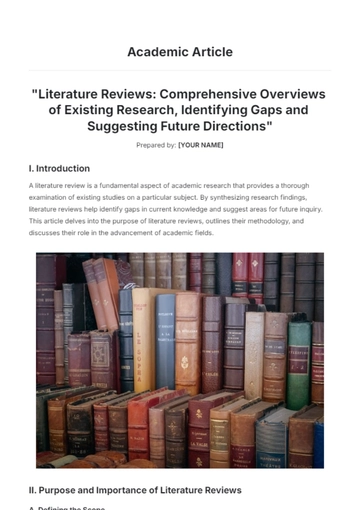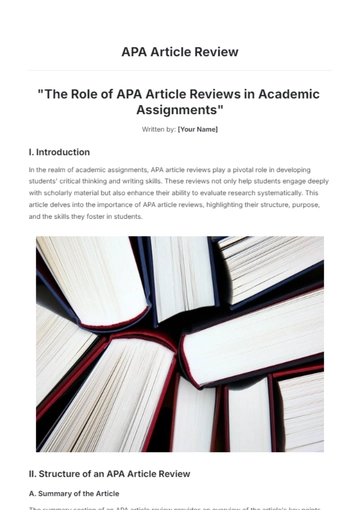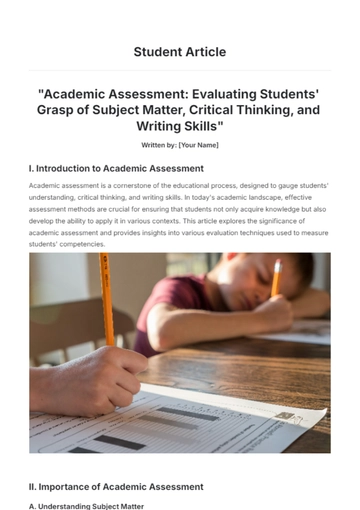Free Evidence-Based Journal Article

The Role of Evidence-Based Practice in Modern Healthcare: A Comprehensive Analysis
Written By: [Your Name]
Introduction to Evidence-Based Practice
In modern healthcare, the concept of Evidence-Based Practice (EBP) has become the cornerstone for delivering high-quality patient care. Evidence-based practice integrates clinical expertise, patient values, and the best available research evidence into the decision-making process for patient care. EBP aims to enhance healthcare outcomes by utilizing well-researched evidence, reducing variability in practice, and making healthcare delivery more systematic and data-driven.
EBP is not a new concept but has evolved significantly over time, aligning closely with advances in clinical research and data analytics. In healthcare settings, it involves formulating clinical questions, searching for the best evidence, appraising that evidence, applying the findings in practice, and evaluating the outcomes. This process, often referred to as the "EBP cycle," ensures that healthcare providers are continuously improving their practices based on solid scientific foundations.
The Evolution of Evidence-Based Practice
Historical Context
The roots of evidence-based practice can be traced back to the work of Archibald Cochrane, a British epidemiologist whose influential book, Effectiveness and Efficiency: Random Reflections on Health Services (1972), highlighted the importance of using scientific evidence to guide medical decisions. Cochrane's work emphasized that many medical practices lacked rigorous evaluation and that more systematic reviews were needed to ensure clinical effectiveness.
By the early 1990s, the concept of evidence-based medicine (EBM) began gaining traction, particularly through the work of David Sackett and colleagues at McMaster University in Canada. Sackett and his team developed EBM as a systematic approach for integrating the best available research with clinical expertise and patient preferences. Over time, EBM evolved into EBP, expanding beyond medicine to include nursing, public health, and allied health professions.
EBP in the 21st Century
Today, evidence-based practice is considered a fundamental framework for healthcare delivery across a variety of disciplines. Advances in digital technologies and the rise of big data have enabled healthcare professionals to access and utilize clinical evidence in real time. Databases such as PubMed, the Cochrane Library, and the Joanna Briggs Institute provide vast resources for healthcare providers to search for evidence that can directly impact patient care.
Moreover, healthcare organizations increasingly demand that their providers implement EBP to ensure standardized, efficient, and effective care. Regulatory bodies and healthcare accreditation agencies now evaluate the extent to which healthcare providers implement EBP in their practice.
The Components of Evidence-Based Practice
Best Available Evidence
The first and perhaps most critical component of EBP is the use of the best available evidence. This evidence comes from a variety of sources, including randomized controlled trials (RCTs), cohort studies, case studies, expert opinions, and qualitative research. Hierarchies of evidence place RCTs and systematic reviews at the top, while observational studies and case reports are considered less reliable. However, EBP recognizes the importance of integrating evidence from multiple sources, particularly in cases where RCTs may not be feasible or ethical.
Healthcare professionals must critically appraise the evidence to determine its validity, relevance, and applicability to specific patient scenarios. Tools such as the GRADE system (Grading of Recommendations Assessment, Development, and Evaluation) help clinicians assess the quality of evidence and make informed care decisions.
Clinical Expertise
While evidence is crucial, clinical expertise remains an essential component of EBP. Expertise refers to the healthcare provider's ability to apply knowledge, skills, and experience to evaluate the evidence and implement it in practice. Clinicians must not only understand the research but also assess how it applies to individual patients, considering factors such as comorbidities, treatment preferences, and potential risks or side effects.
Expertise also includes the clinician’s ability to communicate with patients, interpret clinical findings, and adapt evidence-based recommendations to the unique context of each case. Thus, clinical expertise serves as a bridge between research evidence and patient care.
Patient Preferences and Values
Patient-centered care is a hallmark of EBP, making patient preferences and values a key consideration in the decision-making process. This ensures that healthcare is tailored to the individual needs, expectations, and cultural context of each patient. Patients’ values and preferences may affect their willingness to follow through with certain treatment options, particularly when the evidence suggests multiple viable options.
Incorporating patient preferences requires effective communication and shared decision-making between healthcare providers and patients. Providers must explain the available evidence, outline the potential benefits and risks of different interventions, and work with patients to select the best course of action that aligns with their values.
Applications of Evidence-Based Practice in Healthcare
Evidence-Based Nursing
Evidence-based practice has transformed the field of nursing by emphasizing the use of research to improve patient care outcomes. Nurses are now expected to engage in lifelong learning and keep abreast of the latest research to provide the best possible care. EBP in nursing involves applying evidence to clinical problems, from wound care management to patient education on chronic diseases.
For example, evidence-based guidelines on pressure ulcer prevention have significantly improved the quality of care for bedridden patients. EBP has also contributed to enhancing pain management, infection control, and patient safety measures in hospitals and outpatient settings.
EBP in Public Health
Public health is another area where EBP has had a profound impact. EBP allows public health professionals to make informed decisions about population-based interventions, such as vaccination campaigns, health education, and disease prevention initiatives. By using evidence, public health professionals can prioritize interventions that are most likely to reduce morbidity and mortality in target populations.
An example of EBP in public health is the use of systematic reviews and meta-analyses to determine the effectiveness of smoking cessation programs. By synthesizing the evidence, public health authorities can recommend the most effective interventions, such as behavioral therapy combined with nicotine replacement therapy, to help individuals quit smoking.
EBP in Policy Making
Evidence-based practice also plays a crucial role in healthcare policymaking. Policymakers rely on high-quality evidence to develop guidelines and regulations that promote better health outcomes. For instance, evidence-based guidelines have informed policies on antibiotic stewardship, mental health services, and chronic disease management. The use of evidence in policy-making helps to ensure that healthcare systems adopt interventions that are both effective and cost-efficient.
Barriers to Implementing Evidence-Based Practice
Despite the benefits of EBP, several barriers continue to hinder its full implementation in healthcare settings. One significant challenge is the gap between research and practice, often referred to as the “research-practice divide.” Many healthcare professionals find it difficult to stay up-to-date with the vast amount of new research being published daily. Additionally, some may lack the necessary skills to critically appraise and apply research findings.
Time constraints, limited access to resources, and organizational culture can also pose challenges to the implementation of EBP. In some cases, resistance to change may stem from established traditions in healthcare that are based on habit rather than evidence.
Future Directions for Evidence-Based Practice
Technology and EBP
Looking ahead, technology is expected to play an increasingly significant role in promoting evidence-based practice. Tools such as artificial intelligence (AI), machine learning, and clinical decision support systems (CDSS) can help healthcare providers quickly access the latest research and apply it to patient care in real time. AI algorithms can sift through large volumes of data to identify trends, suggest treatment options, and predict patient outcomes based on evidence.
Expanding the Scope of EBP
As healthcare becomes more interdisciplinary, evidence-based practice is likely to expand beyond traditional healthcare settings. Fields such as social work, counseling, and education are beginning to adopt EBP models, recognizing the value of research in improving outcomes. Additionally, EBP may increasingly incorporate diverse forms of evidence, including patient-reported outcomes, real-world data, and evidence from low- and middle-income countries.
Conclusion
Evidence-based practice is a dynamic and evolving framework that has revolutionized healthcare delivery. By integrating the best available evidence, clinical expertise, and patient preferences, EBP ensures that healthcare is both effective and patient-centered. Although challenges remain in the widespread implementation of EBP, advancements in technology, education, and policy are likely to drive its continued growth in the coming years. Healthcare providers who embrace EBP will be well-positioned to deliver high-quality care that meets the needs of their patients and the demands of a rapidly changing healthcare landscape.
- 100% Customizable, free editor
- Access 1 Million+ Templates, photo’s & graphics
- Download or share as a template
- Click and replace photos, graphics, text, backgrounds
- Resize, crop, AI write & more
- Access advanced editor
Strengthen your research with Template.net’s Evidence-Based Journal Article Template. This editable and customizable template offers a structured format for documenting and presenting evidence-based findings. Editable in our AI Editor Tool, it’s ideal for academics, researchers, and healthcare professionals. Customize the template to fit your study needs, ensuring a clear, organized presentation of evidence-based research in any field.





























